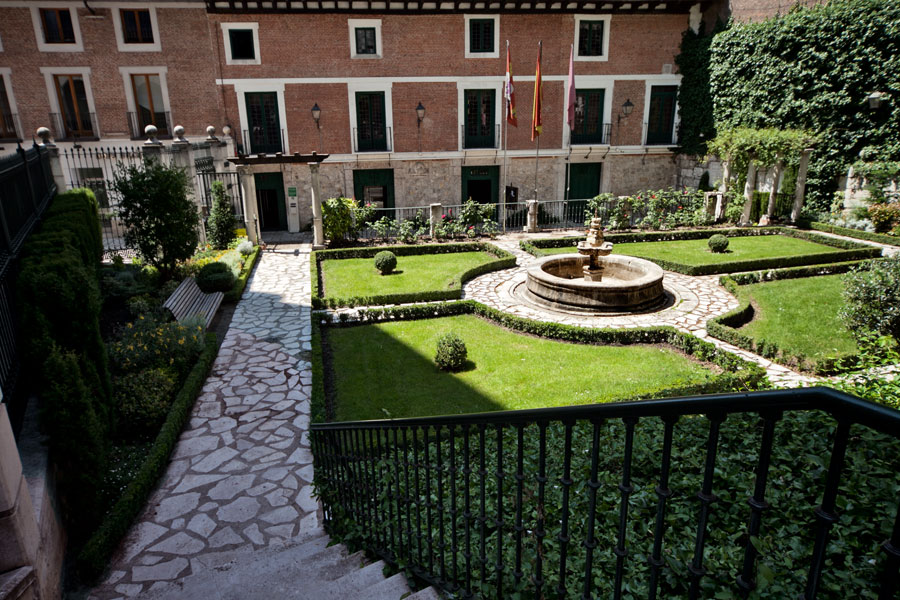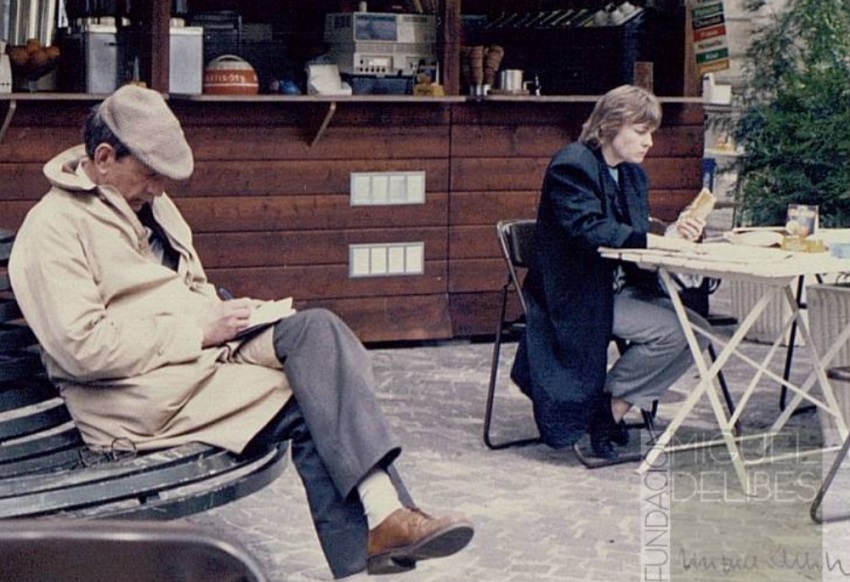Literary Valladolid - Literary Valladolid
Img_cabecera_rincones

Breadcrumb
Breadcrumbs
Asset Publisher
Literary Valladolid
The only house of Cervantes that is preserved
 As inmortal as Don Quixote is the
As inmortal as Don Quixote is the
imprint left by Cervantes in Valladolid. It was the capital of the Court when the writer moved to number 9 Calle del Rastro, a fact verified thanks to the unfortunate murder of Gaspar de Ezpeleta –which landed Cervantes a night in jail, albeit as a witness. Today, it is the Casa de Cervantes Museum, the only original house of the one-armed man from Lepanto that is preserved in Spain. Here, he began the second part of Don Quixote and wrote several Exemplary Novels.
On the wall that separates it from Calle Miguel Íscar, there are six plaques with the following texts: "To the Duke of Béjar... Lord of the towns of Capilla, Curiel, and Burguillos" (dedication from Don Quixote), "...I will tell you a romance... of when the Queen... went to mass after giving birth in Valladolid and went to San Llorente" (La Gitanilla), "...I signed this in Valladolid, on the twentieth day of December, in the year one thousand six hundred and four" (tax of Don Quixote), "I left the Hospital of the Resurrection, which is in Valladolid, outside the Puerta del Campo..." (The Deceitful Marriage), "For this she shall be famous / from Henares to Jarama, / from the Tajo to Manzanares / from Pisuerga to Arlanza" (Don Quixote), and "Let us go to the esplanade to delight our eyes" (The Dialogue of the Dogs).
Some of the Valladolid settings that appear in his novels are, as these plaques remind us, the disappeared Hospital of the Resurrection, of which we still have the facade (in the same courtyard of the museum). The aforementioned Puerta del Campo is also the meeting point set by Avedaño and his guardian in La ilustre fregona. In this work, he also mentions the fountains of Argales. 'San Llorente,' as the plaque states, and La Gitanilla, is the Church of San Lorenzo.
The Esgueva appears in Viaje al Parnaso, but it is the Pisuerga that is mentioned three times: in The Dialogue of the Dogs, in La Galatea, and in Don Quixote.
"I am not asking that, but rather which is the better place: Valladolid or Madrid? And he replied: From Madrid, the extremes; from Valladolid, the middles. I don't understand, the one who asked repeated. And he said: From Madrid, heaven and earth; from Valladolid, the mezzanines": this is how the one-armed man from Lepanto speaks about the city in The Licentiate Vidriera.
Valladolid has paid numerous tributes to Cervantes, such as the statue in Plaza de la Universidad (moved from its original location, the former house of the writer, in the late 19th century) or several plaques that guide us through the most Cervantine corners, in three settings chosen by the illustrious writer to set some of his novels: Casa Mantilla, the Church of San Lorenzo, and the Puente Mayor.
Following in the Footsteps of Zorrilla
 "Isn't it true, angel of love, that on
"Isn't it true, angel of love, that on
this secluded shore the moon shines purer and the air is better?" The author of the most famous verses of Romanticism was born in the current Zorrilla house-museum (Calle Fray Luis de Granada) on February 21, 1817.
In this house, now open to the public, he spent the first years of his childhood, although he soon moved with his parents - a recorder in the Royal Chancery, of strict conservative morals, and an excessively pious woman - to Burgos and Seville. However, he returned soon after to enroll at the University of Valladolid (the current historic building of the UVa), not to attend classes... he showed more interest in drawing, literature, and women. It was during this time that he began to be drawn to authors such as Alexandre Dumas, Victor Hugo, and Espronceda.
The city's appreciation for the poet, who quickly tasted success as a writer, was reflected in works such as Recuerdos de Valladolid, a legend that Zorrilla sets in the Campo Grande, where a fatal duel takes place. The City Council of Valladolid also held him in high esteem, appointing him city chronicler in 1884. He died just four years after receiving this distinction, on January 23, 1893, at the age of 76, following an operation to remove a brain tumor. In 1902, his wish was finally fulfilled, and his body was transferred to the Pantheon of Illustrious Vallisoletans in the Carmen Cemetery of Valladolid, where he rests today.
The city has dedicated heartfelt tributes to Zorrilla, such as the statue that represents him, surrounded by his muses, in the square that bears his name (inaugurated in 1899). An avenue, the main artery of Valladolid, a stadium, a theater, and a secondary education institute have also been dedicated to him.
Remembering Delibes
 The work of Miguel Delibes is a continuous homage to the province of Valladolid. Its fields, pine forests, and villages are constantly exalted in stories with deep devotion to rural life. However, his career takes an unexpected turn towards historical novels with "El Hereje" (National Narrative Prize), in which he recreates the Valladolid of the court of Philip II and the dark era of the Inquisition.
The work of Miguel Delibes is a continuous homage to the province of Valladolid. Its fields, pine forests, and villages are constantly exalted in stories with deep devotion to rural life. However, his career takes an unexpected turn towards historical novels with "El Hereje" (National Narrative Prize), in which he recreates the Valladolid of the court of Philip II and the dark era of the Inquisition.
The so-called 'Route of the Heretic' in honor of this novel visits the most important locations for the town in the 16th century. Several commemorative plaques guide us on a literary walk with deep historical roots. We must not forget that the story revolves around the two great autos-da-fé that took place in May and October of 1559.
We venture into the Valladolid of the court through the eyes of Cipriano Salcedo. He was born in 1517 near Plaza de San Pablo, the epicenter of political life at the time. In the vicinity of the square, Delibes portrays the world of scholars through Ignacio Salcedo, an auditor of the Royal Chancery, as reminded by a square in the Palacio del Licenciado Butrón in Plaza de las Brígidas, and the world of nobles and wealthy merchants in Plaza de Fabio Nelli.
The next square is found in Plaza de la Trinidad. The text informs us that the city's hospice was once located there, an institution that, in the 16th century, was under the care of the Brotherhood of Saint Joseph for Foundling Children, where Cipriano Salcedo studied. Nearby was the Jewish Quarter of Valladolid, where the Salcedo family had their wool warehouse, an export business that determined their economic prosperity and their contact with the Lutheran currents coming from Flanders.
As a 'heretic', Cipriano becomes a disciple of a historical character, Doctor Cazalla. Without leaving the old Jewish quarter, we find the convent of Santa Catalina, a Dominican convent involved in the trial against this preacher, and the Chapel of the Counts of Fuensaldaña, now part of the Museo Patio Herreriano, where his mother, Doña Leonor Vivero, was buried. In the current Calle del Doctor Cazalla, there was the house of Doña Leonor, the center of clandestine meetings organized by her son.
The last stage of the novel addresses the great autos-da-fé, faithful to its historical course. The condemned would attend the ceremony, held as a festive event, in Plaza del Mercado, now Plaza Mayor. They would be dressed with a coroza on their heads and a sambenito on their chests. At the end, the penitentiary prisoners would return to jail, and the others would be mounted on donkeys and taken through Calle Santiago – pausing at its church, where Doctor Cazalla preached every Friday – to the 'burning place of the town' (Plaza Zorrilla), outside the city, where they would face death by the garrote vil or even being burned alive. After the macabre act, the ashes would be collected and scattered, attempting to erase all traces of those whom the Inquisition had condemned.
Valladolid keeps alive the memory of Miguel Delibes. In addition to the Route of the Heretic, which has become an established historical tour regularly offered at the Tourist Office, a modern congress center and auditorium bear his name. His birthplace, at Calle Acera de Recoletos 12, displays a plaque representing a quince fruit and recalling one of his quotes: 'I am a tree that grows where it is planted.'
As a finale, we highlight a curious story written by Anthony Burgess (author of A Clockwork Orange) who imagined a conversation between Cervantes and Shakespeare on the banks of the Pisuerga. The text, "Encounter in Valladolid," is included in the collection of short stories, The Devil's Mode.
The origin of a historical confrontation
"Once upon a time, there was a man with an attached nose" is perhaps the most remembered phrase from the open confrontation between Góngora and Quevedo. Did you know that this enmity took shape in Valladolid? It was in 1601 when a young Francisco de Quevedo, at the age of 21, enrolled in its university. Here, he wrote his first poems under the pseudonym Miguel de Musa – some of them, like "No fuera tanto tu mal," dedicated to the city – his famous "Poderoso caballero es Don Dinero," and his only novel, "El buscón." And it was also here that he began to parody the then-reference poet, Góngora, who, at the age of 42, settled in a court that, as well described in his text "Valladolid, de lágrimas sois valle," did not please him. The poetic diatribes circulating in the city of Esgueva and the playful readings in taverns accentuated the rivalry between an established writer and a witty student, which would become the most remembered confrontation of the Golden Age.
Valladolid, a city of literature
The relationship between the city and literature has always been close. It is here that Rosa Chacel was born, who roams the streets of Valladolid in "Memorias de Leticia Valle," a tribute that brings her back to her homeland with a statue representing her in the Campo Grande. The quintessential romantic garden also pays tribute, with two busts, to two illustrious Valladolid figures: the playwright Leopoldo Cano and the poet Nuñez de Arce.
Beyond this intimate space, memories of other authors born in the capital of the Pisuerga are repeated: the poet Jorge Guillén (with his plaque on Calle Constitución and a sculpture, signed by Chillida, on the side of the National Sculpture Museum), the poet, journalist, and member of the Royal Spanish Academy, Francisco Javier Martín Abril (plaque at number 16 Calle López Gómez), the aforementioned Nuñez de Arce (the house where he was born, on the street bearing his name, attests to it), or the poet Emilio Ferrari (a plaque commemorates his place of birth on the street that bears his name).
Many writers have been captivated by our city. From classics like Cervantes or Quevedo, the irreplaceable Romantic poet José Zorrilla, or, at the dawn of the 20th century, the Italian Leonardo Sciascia, for whom "...Valladolid was a beautiful and ancient city where I would have stayed forever..." as recalled by the text engraved in the Plaza del Palacio de Santa Cruz.
Perhaps you have read some of the books set in Valladolid, such as those signed by Francisco Umbral (including "La capital del dolor") or Gustavo Martín Garzo (such as "Las historias de Marta y Fernando," winner of the Nadal Prize), or one of the latest bestselling Spanish novels like "Memento Mori" by César Pérez Gellida. If you enjoy historical novels, you can delve into the courtly Valladolid with books such as "María de Molina" by Almudena de Arteaga, "La corte de los ingenios" by Ignacio Martín Verona, "Los ojos de Dios" by Rafaela Cano, or "El castillo de diamante" by Juan Manuel de Prada.
As a culmination, we highlight a curious story written by Anthony Burgess (author of "A Clockwork Orange") who imagined a conversation between Cervantes and Shakespeare on the banks of the Pisuerga. The text, "Encuentro en Valladolid," is included in the collection of short stories, "The Devil's Mode."
Related Assets
Navigation Menu
Navigation Menu
Organize your trip
Información turística
Tourist Office on Acera de Recoletos
Open Monday to Saturday from 9:30 a.m. to 2 p.m. and from 4 p.m. to 7 p.m. Sundays, from 9:30 a.m. to 2 p.m.
Phone: 983 21 93 10
Tourist Office on San Benito, Calle de San Benito s/n
Open Monday to Saturday from 10 a.m. to 2 p.m. and from 4 p.m. to 7 p.m. Sundays, from 10 a.m. to 2 p.m.
Phone: 983 42 61 93
Tourist Information Point at the Train Station
Open Tuesday to Saturday from 10 a.m. to 2 p.m. and from 4 p.m. to 7 p.m. Sundays, from 10 a.m. to 2 p.m.
Phone: 983 42 60 30
Widget tiempo Valladolid
Related Assets
Maybe you're interested too...

